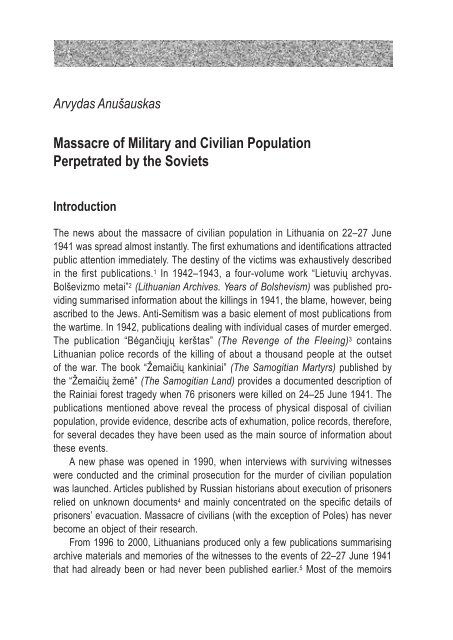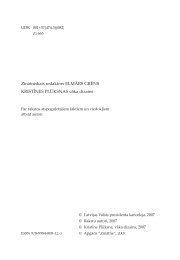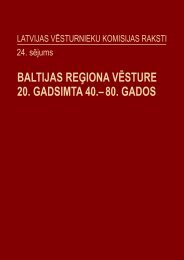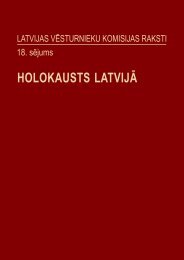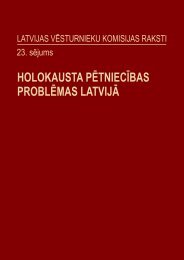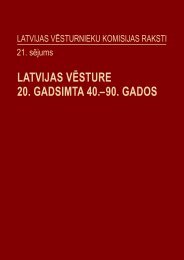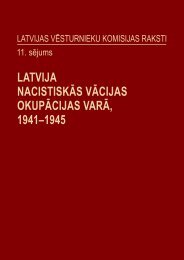- Page 1: LATVIJAS VĒSTURNIEKU KOMISIJAS RAK
- Page 4 and 5: Latvijas Vēsturnieku komisija Latv
- Page 6 and 7: SATURS Priekšvārds . . . . . . .
- Page 8 and 9: Saturs Juris Pavlovičs No Man’s
- Page 10 and 11: PRIEKŠVĀRDS Jau piecpadsmito reiz
- Page 12 and 13: Priekšvārds Karaspēka drosmes, l
- Page 14 and 15: PADOMJU OKUPĀCIJA 1940-1941 SOVIET
- Page 16 and 17: Alfreds Erihs Senns Baltijas kaujas
- Page 18 and 19: Alfreds Erihs Senns. Baltijas kauja
- Page 20 and 21: Alfreds Erihs Senns. Baltijas kauja
- Page 22 and 23: Alfreds Erihs Senns. Baltijas kauja
- Page 24 and 25: Alfreds Erihs Senns. Baltijas kauja
- Page 26 and 27: Alfreds Erihs Senns. Baltijas kauja
- Page 28 and 29: Alfreds Erihs Senns. Baltijas kauja
- Page 30 and 31: Alfreds Erihs Senns. Baltijas kauja
- Page 34 and 35: Arvydas Anušauskas. Massacre of Mi
- Page 36 and 37: Arvydas Anušauskas. Massacre of Mi
- Page 38 and 39: Arvydas Anušauskas. Massacre of Mi
- Page 40 and 41: Arvydas Anušauskas. Massacre of Mi
- Page 42 and 43: Arvydas Anušauskas. Massacre of Mi
- Page 44 and 45: Arvydas Anušauskas. Massacre of Mi
- Page 46 and 47: Kseniya Petrochenko. Problems of Se
- Page 48 and 49: Kseniya Petrochenko. Problems of Se
- Page 50 and 51: Kseniya Petrochenko. Problems of Se
- Page 52 and 53: LATVIJA NACISTISKĀS VĀCIJAS OKUP
- Page 54 and 55: Inesis Feldmanis Nacistu okupācija
- Page 56 and 57: Inesis Feldmanis. Nacistu okupācij
- Page 58 and 59: Inesis Feldmanis. Nacistu okupācij
- Page 60 and 61: Inesis Feldmanis. Nacistu okupācij
- Page 62 and 63: Inesis Feldmanis. Nacistu okupācij
- Page 64 and 65: Inesis Feldmanis. Nacistu okupācij
- Page 66 and 67: Inesis Feldmanis. Nacistu okupācij
- Page 68 and 69: Inesis Feldmanis. Nacistu okupācij
- Page 70 and 71: Inesis Feldmanis. Nacistu okupācij
- Page 72 and 73: Antonijs Zunda Baltijas valstu prob
- Page 74 and 75: Antonijs Zunda. Baltijas valstu pro
- Page 76 and 77: Antonijs Zunda. Baltijas valstu pro
- Page 78 and 79: Antonijs Zunda. Baltijas valstu pro
- Page 80 and 81: Antonijs Zunda. Baltijas valstu pro
- Page 82 and 83:
Antonijs Zunda. Baltijas valstu pro
- Page 84 and 85:
Antonijs Zunda. Baltijas valstu pro
- Page 86 and 87:
Antonijs Zunda. Baltijas valstu pro
- Page 88 and 89:
Antonijs Zunda. Baltijas valstu pro
- Page 90 and 91:
Antonijs Zunda. Baltijas valstu pro
- Page 92 and 93:
Antonijs Zunda. Baltijas valstu pro
- Page 94 and 95:
Boris Sokolov. The Baltic States in
- Page 96 and 97:
Boris Sokolov. The Baltic States in
- Page 98 and 99:
Boris Sokolov. The Baltic States in
- Page 100 and 101:
Markku Jokisipilä Between the Uppe
- Page 102 and 103:
Markku Jokisipilä. Between the Upp
- Page 104 and 105:
Markku Jokisipilä. Between the Upp
- Page 106 and 107:
Markku Jokisipilä. Between the Upp
- Page 108 and 109:
Markku Jokisipilä. Between the Upp
- Page 110 and 111:
Markku Jokisipilä. Between the Upp
- Page 112 and 113:
Markku Jokisipilä. Between the Upp
- Page 114 and 115:
Markku Jokisipilä. Between the Upp
- Page 116 and 117:
Markku Jokisipilä. Between the Upp
- Page 118 and 119:
Markku Jokisipilä. Between the Upp
- Page 120 and 121:
Markku Jokisipilä. Between the Upp
- Page 122 and 123:
Markku Jokisipilä. Between the Upp
- Page 124 and 125:
Markku Jokisipilä. Between the Upp
- Page 126 and 127:
Markku Jokisipilä. Between the Upp
- Page 128 and 129:
Kārlis Kangeris. 1995.-2004. gadā
- Page 130 and 131:
Kārlis Kangeris. 1995.-2004. gadā
- Page 132 and 133:
Kārlis Kangeris. 1995.-2004. gadā
- Page 134 and 135:
Kārlis Kangeris. 1995.-2004. gadā
- Page 136 and 137:
Kārlis Kangeris. 1995.-2004. gadā
- Page 138 and 139:
Kārlis Kangeris. 1995.-2004. gadā
- Page 140 and 141:
Kārlis Kangeris. 1995.-2004. gadā
- Page 142 and 143:
Kārlis Kangeris. 1995.-2004. gadā
- Page 144 and 145:
Kārlis Kangeris. 1995.-2004. gadā
- Page 146 and 147:
Juris Pavlovičs. Okupācijas varu
- Page 148 and 149:
Juris Pavlovičs. Okupācijas varu
- Page 150 and 151:
Juris Pavlovičs. Okupācijas varu
- Page 152 and 153:
Juris Pavlovičs. Okupācijas varu
- Page 154 and 155:
Juris Pavlovičs. Okupācijas varu
- Page 156 and 157:
Uldis Neiburgs. Latvijas Republikas
- Page 158 and 159:
Uldis Neiburgs. Latvijas Republikas
- Page 160 and 161:
Uldis Neiburgs. Latvijas Republikas
- Page 162 and 163:
Uldis Neiburgs. Latvijas Republikas
- Page 164 and 165:
Uldis Neiburgs. Latvijas Republikas
- Page 166 and 167:
Uldis Neiburgs. Latvijas Republikas
- Page 168 and 169:
Uldis Neiburgs. Latvijas Republikas
- Page 170 and 171:
Uldis Neiburgs. Latvijas Republikas
- Page 172 and 173:
PADOMJU OKUPĀCIJA 1944-1959 SOVIET
- Page 174 and 175:
Heinrihs Strods Latvijas sovetizāc
- Page 176 and 177:
Heinrihs Strods. Latvijas sovetizā
- Page 178 and 179:
Heinrihs Strods. Latvijas sovetizā
- Page 180 and 181:
Heinrihs Strods. Latvijas sovetizā
- Page 182 and 183:
Heinrihs Strods. Latvijas sovetizā
- Page 184 and 185:
Heinrihs Strods. Latvijas sovetizā
- Page 186 and 187:
Heinrihs Strods. Latvijas sovetizā
- Page 188 and 189:
Heinrihs Strods. Latvijas sovetizā
- Page 190 and 191:
Heinrihs Strods. Latvijas sovetizā
- Page 192 and 193:
Heinrihs Strods. Latvijas sovetizā
- Page 194 and 195:
Daina Bleiere Pēckara posms (1944-
- Page 196 and 197:
Daina Bleiere. Pēckara posms (1944
- Page 198 and 199:
Daina Bleiere. Pēckara posms (1944
- Page 200 and 201:
Daina Bleiere. Pēckara posms (1944
- Page 202 and 203:
Daina Bleiere. Pēckara posms (1944
- Page 204 and 205:
Daina Bleiere. Pēckara posms (1944
- Page 206 and 207:
Daina Bleiere. Pēckara posms (1944
- Page 208 and 209:
Daina Bleiere. Pēckara posms (1944
- Page 210 and 211:
Daina Bleiere. Pēckara posms (1944
- Page 212 and 213:
Ritvars Jansons Latvijas PSR droš
- Page 214 and 215:
Ritvars Jansons. Latvijas PSR droš
- Page 216 and 217:
Ritvars Jansons. Latvijas PSR droš
- Page 218 and 219:
Ritvars Jansons. Latvijas PSR droš
- Page 220 and 221:
Ritvars Jansons. Latvijas PSR droš
- Page 222 and 223:
Ritvars Jansons. Latvijas PSR droš
- Page 224 and 225:
LATVIJAS VĒSTURNIEKU KOMISIJAS PAZ
- Page 226 and 227:
Latvijas okupācija: vēsturiskie u
- Page 228 and 229:
Inesis Feldmanis. Latvijas okupāci
- Page 230 and 231:
Inesis Feldmanis. Latvijas okupāci
- Page 232 and 233:
Inesis Feldmanis. Latvijas okupāci
- Page 234 and 235:
Inesis Feldmanis. Latvijas okupāci
- Page 236 and 237:
Inesis Feldmanis. Latvijas okupāci
- Page 238 and 239:
Inesis Feldmanis, Kārlis Kangeris.
- Page 240 and 241:
Inesis Feldmanis, Kārlis Kangeris.
- Page 242 and 243:
Inesis Feldmanis, Kārlis Kangeris.
- Page 244 and 245:
Inesis Feldmanis, Kārlis Kangeris.
- Page 246 and 247:
LATVIJAS VĒSTURNIEKU KOMISIJAS RAK
- Page 248 and 249:
Rakstu krājumi 1. Latvija Otrajā
- Page 250 and 251:
Rakstu krājumi 11. Latvija nacisti
- Page 252 and 253:
Rakstu krājumos ievietotie raksti
- Page 254 and 255:
Rakstu krājumos ievietotie raksti
- Page 256 and 257:
Rakstu krājumos ievietotie raksti
- Page 258 and 259:
Rakstu krājumos ievietotie raksti
- Page 260 and 261:
Rakstu krājumos ievietotie raksti
- Page 262 and 263:
Rakstu krājumos ievietotie raksti
- Page 264 and 265:
Rakstu krājumos ievietotie raksti
- Page 266 and 267:
Rakstu krājumos ievietotie raksti
- Page 268 and 269:
Rakstu krājumos ievietotie raksti
- Page 270 and 271:
Rakstu krājumos ievietotie raksti
- Page 272 and 273:
Rakstu krājumos ievietotie raksti
- Page 274 and 275:
Rakstu krājumos ievietotie raksti
- Page 276 and 277:
Rakstu krājumos ievietotie raksti
- Page 278 and 279:
Rakstu krājumos ievietotie raksti
- Page 280 and 281:
Rakstu krājumos ievietotie raksti
- Page 282 and 283:
Autoru rādītājs Karlsons Gatis 2
- Page 284 and 285:
KRĀJUMĀ IEVIETOTO RAKSTU AUTORU S


